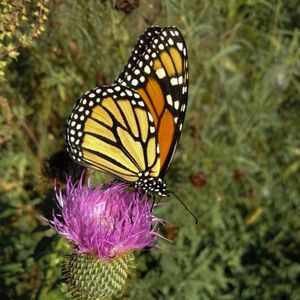It’s Charlie, the Crane Trust Saunders Conservation Fellow here! In celebration of our native pollinators, I’ll dive into the exciting work going on here to help conserve some very important critters and their habitat. In addition to monitoring species of concern, the Crane Trust works to keep healthy, native, diverse, and connected habitats for pollinators.


Our focus this summer revolves around moths and butterflies. The most well-known pollinator butterflies you’ll see here are the Monarch (Danaus plexippus) and the Regal Fritillary (Speyeria idalia). The Regal Fritillary (pictured above) thrives in tall-grass prairies and wet meadows. It is a species of concern here - vital to the health of wet meadow plants and flowers and declining in population and range. They are beneficial to native thistles, milkweeds, hoary vervain (pictured below), and other flowers.


The monarch is another important butterfly of concern that’s present in the Central Platte region during the spring and summer. Like the fritillaries, they love open fields and meadows. The caterpillars of monarchs depend upon local native milkweeds: swamp milkweed (Asclepias incarnata), showy milkweed (Asclepias speciosa), and common milkweed (Asclepias syriaca). Fun fact: the milkweed diet of the caterpillars gives them a poisonous compound that makes them undesirable to predators!


We get to trek out with our binoculars into wet meadows on warm and wind-free days to see how many species of concern we can spot. We’ll keep track of plants they’re visiting and other habitat characteristics. While our current research mostly focuses on butterflies and moths, there are countless other pollinator species. The Crane Trust has research on several local bumblebee species and has helped out with ongoing citizen science projects. Check out the Nebraska Bumblebee Atlas to learn about bees and even get involved in monitoring!

We can’t forget about some other helpful pollinators! When you think of fun flying insects, you may not think of flies, but they are an underrated and very influential pollinator here. Many species of pollinating fly are often overlooked because they can be mistaken for bees. Hoverflies (Syrphidae) and bee flies (Bombyliidae) are great visitors to native bee balm, violets, and thistles. ID tip: bees have two pairs of wings (4 total) and flies just have one pair.
If you see beetles and wasps hanging out on flowers, they are also helping out. And guess what? Not all pollinators have wings! Small mammals, skinks, and even slugs play a part.

Pollinators in the Platte River wet meadow region are both benefited by and contribute to the diversity and health of native flowering plants. They are an integral part of a huge web of interacting plants and wildlife. By working to maintain healthy connected habitats and monitor species of concern, we hope to keep a high-functioning ecosystem for everything that lives here.

You may see lots of pollinators during the day, but don't forget - there are nighttime pollinators too. Check back soon to get a peek into the Crane Trust’s exciting nighttime moth research!

